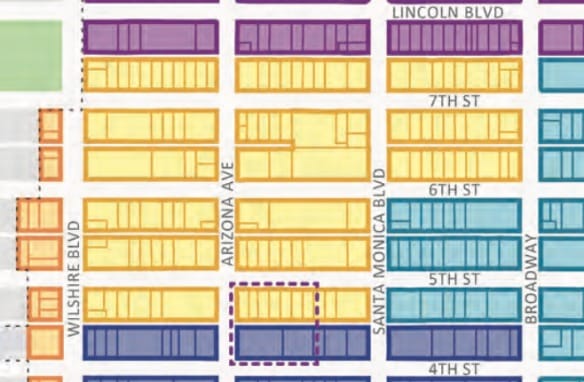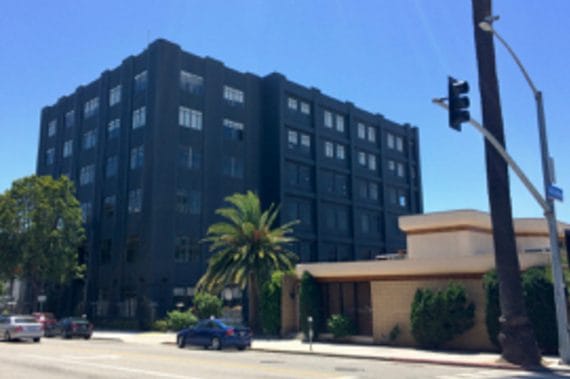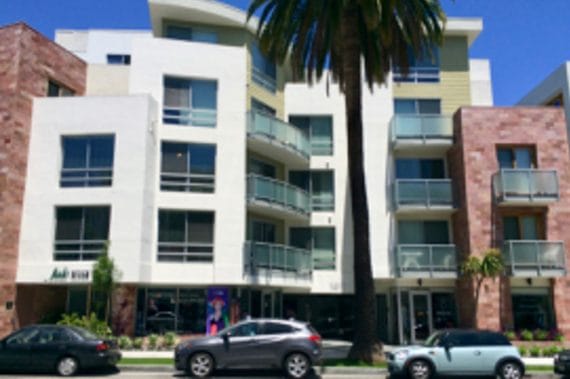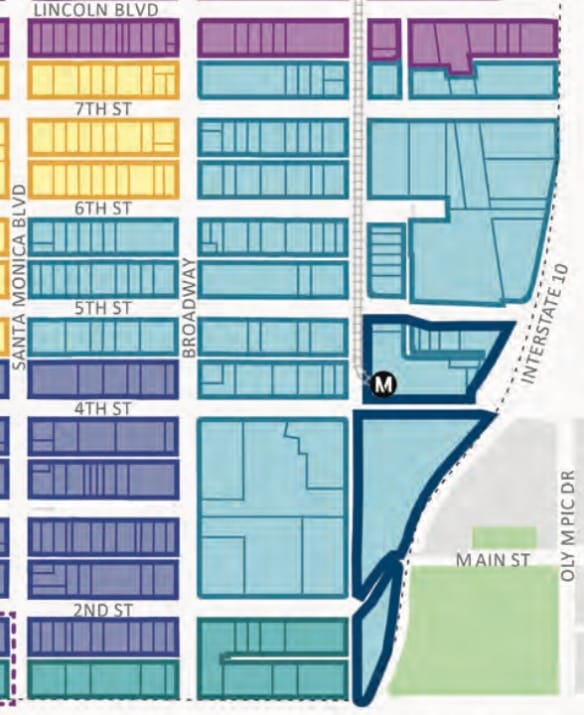The following post originally appeared on Healthy City Local.
It’s back! The latest (and promised final!) version of Santa Monica’s Downtown Community Plan (DCP), is being dragged through the Planning Commission, with an ultimate destination of the Promised Land, namely approval by the City Council. The DCP is the current installment of Santa Monica’s quasi-permanent, general plan-level, planning process, now approaching the middle of its second decade.
Late last year I wrote three articles about the previous, 2016 version of the DCP, and I’ll probably write at least three about this iteration, too. In some respects the 2016 version has been improved, and some others it’s been made worse, but my overall reaction to the plan has not changed: the plan is more a political document than a planning document.
By “political” I mean that more of the plan’s 290 pages are explaining than are planning. The DCP is the product of staff and consultants who’ve been yelled at a lot, and who are trying to anticipate the path of least political resistance so that they can get enacted something that at least rhetorically they can be proud of.
As a result, much of the plan is not planning but flattery — not only soothing words to make Santa Monicans feel special and fawned upon, but also flattery for the plan itself. Never are Santa Monicans told the truth, which is that much of downtown has been and is a dump, needs new investment, and dammit it could be made a lot better.
Instead, we get a lot of how the DCP will preserve “character and history,” and carefully integrate “the new with the best of the old,” and “carefully nurture Downtown’s character and sense of the past,” not only with “enhanced historic preservation,” but also with “context sensitive infill.” There’s a lot about “sustainability” and “wellbeing.”
We’re constantly being told about downtown’s character, as if it’s the hero or heroine of a romance novel, as if the “scale” of downtown has anything to do with its success. We all know that but for locating new movie theaters downtown and getting a good designer (Boris Dramov) to fix up what was then the Third Street Mall, Downtown Santa Monica would still be the scary ghost town it was in 1981 when, as a member of the Odyssey Theatre’s board, I tried to persuade Third Street property owners to subsidize a theater for the Odyssey to bring some life to the decrepit pit. (Thankfully Denny Zane, whom I first met at the time, ultimately had a more realistic vision.)
When the planners aren’t patting us on the back for being so brilliant because we happen to have a vibrant downtown (I guess we should take credit for the ocean, too), we get reassurances about the plan itself like these:
The community’s expectation for the Downtown area to expand as an energetic, equitable and sustainable urban neighborhood is addressed [by the DCP] through physical land-use planning integrated with circulation policies, and a well-rounded emphasis on community services and amenities. Many of the policies and actions throughout this document aspire to nurture neighborhood and economic prosperity . . . .
Good to know! I’d hate to have a plan that aspires to destroy neighborhood and economic prosperity.
Last year I wrote about how the euphemisms in the plan annoyed me, and my bête noire was calling a crucial core piece of downtown, seven and a half mostly underdeveloped blocks straddling two major transit boulevards, the “Neighborhood Village.”
Here’s a map of the “Neighborhood Village” (NV) (in yellow):
You know these blocks: It’s not like there are dirt roads and thatched roofs there, or cows and chickens. This is where the Main Library and the YMCA are. The new hotel at 710 Wilshire, incorporating a large landmarked structure, is under construction. Some of the other large buildings in Downtown are there, too. Here’s a picture of Sixth Street north of Arizona, showing Santa Monica Towers.
And don’t forget the former telephone company building that now houses the restaurant Cassia.
Not only that, but much development of mixed-use buildings, with typically four stories of apartments over a ground floor of retail or small offices, has already occurred in the district, like this one.
The DCP doesn’t note how much better these new developments have made the area from what it was before. For all the charm and character the DCP assures us downtown has, the older buildings on the NV blocks are mostly an incongruous collection of bad modernism and worse kitsch, all punctuated by parking lots and “cars behind bars” curb cuts and black holes. Here are some of my favorites.



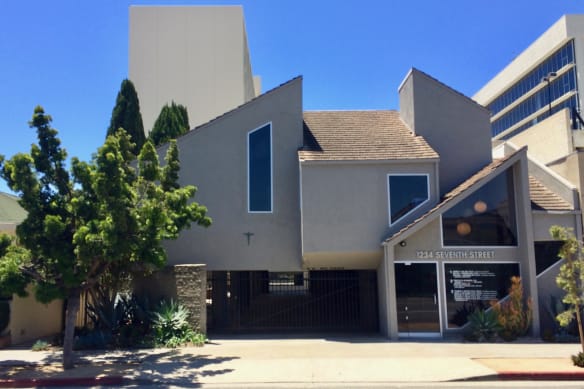
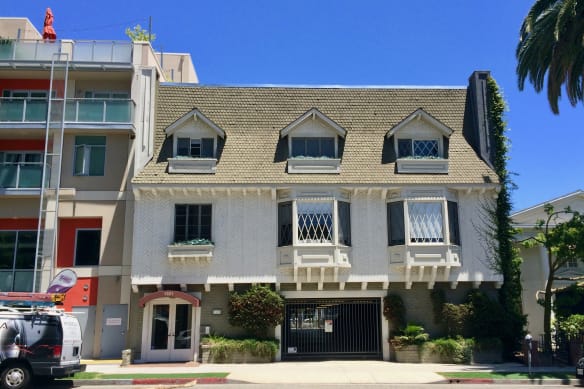


Sure, there are a few vestigial wood-framed throwbacks to when, more than a century ago, downtown was at least village-like, but there is no village there now. Instead, on their own, with largely private investment, these blocks have, since the City liberalized the zoning for housing 20 years ago, been making an excellent transition to a mixed, post-sprawl neighborhood of five-story apartments, shops, offices, hotels and public-serving uses. It’s the past 20 years of development, not some false nostalgia, that the DCP should be celebrating and building upon.

So one has to ask, why do intelligent planners and consultants call an area like this a village? The answer is political. The more distinctions the planners can make in the amount of development allowed from one area to another, the more they can demonstrate (truthfully in fact) that they’re listening to those residents who are angry about any and all development.
Let me step back for a moment from my criticism to say that I don’t believe that the amount of development the DCP allows is, in most instances, too little for downtown. The problems with getting housing built, that many people are complaining about and about which I’ll write in a future column, have more to do with the approval process than with the amount of development allowed.
But look at the difference between the amount of development (which is expressed by the permitted “floor-area ratio,” or FAR) that the DCP allows in the NV area and the amount allowed in the “Transit Adjacent” (TA) area immediately to the south. Here’s a map of the Transit Adjacent area (in turquoise):
In TA, for Tier 2 projects with housing, the DCP allows for an FAR of 3.5 while the NV only allows 3.25. (A quarter point of FAR is financially significant, especially considering the costs that the City lays on housing development.) When it comes to larger developments, TA allows for Tier 3 projects with potentially an FAR of 4.0 (which is about what apartment buildings got under the 1990s zoning that allowed a double FAR for housing, so it’s not too much), while the NV doesn’t allow Tier 3 projects at all.
Not only that, the TA area is already more built-out than the NV area, or occupied by uses like the City’s bus yards. So the NV area is a more promising area for continued residential growth.
There is no reason to make a distinction between the NV blocks, which are either between or straddle Santa Monica and Wilshire Boulevards, and the TA blocks between Santa Monica and Colorado. The former are a little further from the Expo station, but both Wilshire and Santa Monica Boulevard are routes for Metro Rapid buses that will, within the lifetime of the DCP, connect with the Purple Line subway, as well as major Big Blue Bus routes to UCLA and elsewhere.
When there is no real reason to make a distinction, look for a political one.
Call it a village.
Thanks for reading.

